Papaya: Insect, Mite and Nematode Pests Management
Papaya: Insect, Mite and Nematode Pests Management
Papaya mealybug
Biology- Egg: Females usually lay 100 to 600 eggs. Eggs are greenish yellow and are laid in an ovisac sac that is three to four times the body length and entirely covered with white wax. Egg-laying usually continuous over a period of one to two weeks.
- Nymph: Eggs hatch in about 10 days, and nymphs or crawlers begin to actively search for feeding sites.
- Adult: The adult female is yellow, approximately 3 mm long and 1.4 mm wide and is covered with a white waxy coating. Adult males are pink, especially during the pre-pupal and pupal stages, but appear yellow in the first and second in stars. Adult males are approximately 1.0 mm
- Initially the affected portion will be cholotic, later changed to brown and dry away.
- These bug excrete honey dew and as a result infested portion becomes shiny and moist and to this, secondary infection by sooty fungus, Capnodium occurs results in black covering the affected parts.
- Papaya mealy bug is polyphagous pest. Symtopms can be observed on ground parts of leaves, stem and fruits as clusters of cotton like masses

- Parasitoids: Acerophagus papaya, Phygadium spp.
- Predators: Spalgis epius (West wood), Cryptolaemus montrouzieri, Rodolia fumida
- The entomogenous fungus Beauveria bassiana.
Whitefly
Biology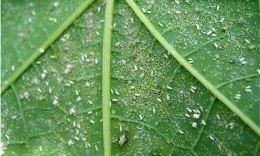 Egg: The females mostly lay eggs near the veins on the underside of leaves. Each female can lay about 300 eggs in its lifetime. Eggs are small (about 0.25 mm), pear-shaped, and vertically attached to the leaf surface through a pedicel. Newly laid eggs are white and later turn brown.
Egg: The females mostly lay eggs near the veins on the underside of leaves. Each female can lay about 300 eggs in its lifetime. Eggs are small (about 0.25 mm), pear-shaped, and vertically attached to the leaf surface through a pedicel. Newly laid eggs are white and later turn brown.- Nymph: Upon hatching, the first instar larva (nymph) moves on the leaf surface to locate a suitable feeding site. Hence, it is commonly known as a “crawler.” If then inserts its piercing and sucking mouthpart and begins sucking the plant sap from the phloem. Adults emerge from puparium through a T-shaped slit, leaving behind empty pupal cases or exuviae.
- Adult: The whitefly adult is a soft-bodied, and moth-like fly. The wings are covered with powdery wax and the body is light yellow in color. The wings are held over the body like a tent. The adult males are slightly smaller in size than the females. Adults live from one to three weeks.
- Both the adults and nymphs suck the plant sap and reduce the vigor of the plant. In severe infestations, the leaves turn yellow and drop off. When the populations are high they secrete large quantities of honeydew, which favors the growth of sooty mould on leaf surfaces and reduces the photosynthetic efficiency of the plants.
- Parasitoids: Encarsia formosa, Eretmocerus spp., Chrysocharis pentheus
- Predators: Dicyphus hesperus , Lacewing, Ladybird beetle, Big-eyed bugs (mirid bug) (Geocorissp).
Aphid
Biology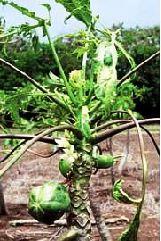 Egg: Eggs are very tiny, shiny-black, and are found in the crevices of bud, stems, and barks of the plant. Aphids usually do not lay eggs in warm parts of the world.
Egg: Eggs are very tiny, shiny-black, and are found in the crevices of bud, stems, and barks of the plant. Aphids usually do not lay eggs in warm parts of the world.- Nymph: Nymphs (immature stages) are young aphids, they look like the wingless adults but are smaller. They become adults within 7 to 10 days.
- Adult: Adults are small, 1 to 4 mm long, soft-bodied insects with two long antennae that resemble horns. Most aphids have two short cornicles (horns) towards the rear of the body
- Infesting tender shoots and under surface of the leaves.
- Curling and crinkling of leaves
- Stunted growth
- Development of black sooty mould due to the excretion of honeydew
- Parasitoids: Aphidius colemani, Aphelinus sp.,
- Predators: Fire ant, Robber flies, Big-eyed bug (Geocoris sp), Earwig, Ground beetle, Cecidomyiid fly, Dragon fly, Praying mantis, Lacewing, Ladybird beetle, Spider etc.
Red Spider mite
Biology- Egg: Eggs reddish, spherical and provided with a small filament. Incubation period is 4-6 days, before hatching becomes light orange colour.
- Nymph: Upon hatching, it will pass through a larval stage and two nymphal stages before becoming adult. Developmental stages include six legged larva, protonymph and deutonymph.
- Adult: Adult female elliptical in shape, bright crimson anteriorly and dark pruplish brown posteriorlym. Mites spin a web of silken threads on the leaf. Each developmental stage is followed by a quiescent stage and life cycle completed in 10-14 days.
- Spider mites usually extract the cell contents from the leaves using their long, needle- like mouthparts. This results in reduced chlorophyll content in the leaves, leading to the formation of white or yellow speckles on the leaves.
- In severe infestations, leaves will completely desiccate and drop off. The mites also produce webbing on the leaf surfaces in severe conditions.
- Under high population densities, the mites move to using strands of silk to form a ball-like mass, which will be blown by winds to new leaves or plants, in a process known as “ballooning.”
- Predators: Anthocorid bugs (Orius spp.), mirid bugs, syrphid/hover flies, green lacewings (Mallada basalis and Chrysoperlasp.), predatory mites (Amblyseius alstoniae, A. womersleyi, A. fallacies and Phytoseiulus persimilis), predatory coccinellids (Stethorus punctillum), staphylinid beetle (Oligota spp.), predatory cecidomyiid fly (Anthrocnodax occidentalis), predatory gall midge (Feltiella minuta), Predatory thrips etc.
Fruit fly
Biology Egg: Female flies insert eggs under the skin of fruit in clusters of 10 to 50 about 1/25 to 1/8 inch below the fruit surface. The eggs measure about 1/25 by 1/250 inch and are white, elongate, and elliptical. They hatch in 1-1/2 days.
Egg: Female flies insert eggs under the skin of fruit in clusters of 10 to 50 about 1/25 to 1/8 inch below the fruit surface. The eggs measure about 1/25 by 1/250 inch and are white, elongate, and elliptical. They hatch in 1-1/2 days. - Larva: The white larva is legless, and resembles an elongated cone. The mouth is at the pointed end of the body. There are 3 larval stages, or instars. The third instar is about 2/5 inch long. The entire larval stage lasts for 11-15 days.
- Pupa: When mature, larvae drop to the ground and pupate in the soil. The puparium is yellowish-brown and seed-like. Adults emerge in about 10 days.
- Adult: Generally, the abdomen has two horizontal black stripes and a longitudinal median stripe extending from the base of the third segment to the apex of the abdomen. These markings may form a "T" shaped pattern, but the pattern varies considerably. Females begin to lay eggs about 8 days after emergence from the puparium. Under optimum conditions, a female can lay more than 3,000 eggs during her lifetime, but under field conditions approximately 1,200 to 1,500 eggs per female is considered to be the usual production. Ripe fruit are preferred for egg laying, but immature ones may be also attacked.
- The female punctures outer wall of mature fruits with the help of its pointed ovipositor and insert eggs in small clusters inside mesocarp of mature fruits.
- On hatching, the maggots feed on fruit pulp and the infested fruits start rotting due to further secondary infection
- Parasitoids: Opius fletcheri, Fopius arisanus, Diachasmimorpha kraussi
- Predator: Ants
Grasshopper
Biology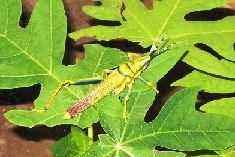 Egg: Adult females lay eggs along the midrib and lateral veins of the leaves. The egg period is 4 to 11 days.
Egg: Adult females lay eggs along the midrib and lateral veins of the leaves. The egg period is 4 to 11 days.- Nymph: The nymphs resemble the adults, but lack wings. Instead, they have slightly extended wing pads. They are pale green in color. They tend to move sideways when disturbed. The nymphal period varies from one to four weeks depending on the temperature.
- Adult: The adults are wedge-shaped, pale green insects. They have fully developed wings with a prominent black spot on each forewing. The adults may live for one to two months
- Both nymphs and adults suck the sap from the lower leaf surfaces through their piercing and sucking mouthparts. While sucking the plant sap, they also inject toxic saliva into the plant tissues, which leads to yellowing. When several insects suck the sap from the same leaf, yellow spots appear on the leaves, followed by crinkling, curling, bronzing, and drying, or “hopper burn”.
- Parasitoids: Lymaenon empoascae (egg), Anagrus flaveolus, Stethynium triclavatum
- Predators: Birds, praying mantis, blister beetle, ground beetle, spider, hoverfly etc.,
Reniform nematode
Biology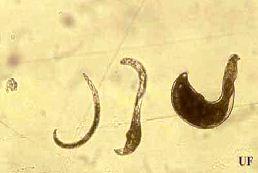 The predominant reniform species found on papayas in most of the world is R. reniformis.
The predominant reniform species found on papayas in most of the world is R. reniformis.- Many commonly cultivated crops as well as weeds are hosts of the reniform nematodes.
- Because of their small size, they do not travel distances of more than a few inches in their lifetime.
- Juveniles that hatch from eggs are less than 500 μm long.
- After undergoing several molts, female juveniles become young adults and penetrate the root cortext and become sedentary.
- The portion of the body that remains outside the root enlarges and becomes kidney-shaped, hence the name "reniform." After maturation the female secrets a gelatinous substance around her body (the sand-like bodies referred to above) into which she lays about 100 eggs.
- A complete life cycle is possible in about 25 days. The reniform nematode feeds near the phloem in papaya roots inducing the formation of giant cells.
- These are centers of high metabolic activity that compete with other parts of the plant for food and nutrients.
- The nematode also may feed in the root cortex and cause mechanical breakdown of the cortical cells, thus providing suitable sites for attack by fungi.
- Above-ground symptoms of plants infected by the reniform nematode are similar to those associated with one or more of the following conditions: 1) lack of proper nutrients, 2) chronic moisture stress, and/or 3) poor soil aeration.
- The above-ground symptoms appear as moderate to severe leaf chlorosis and plant stunting. Some wilting may occur during periods of peak transpirational stress on the plant.
- Below ground symptoms are not readily detectable by the untrained observer. However, reniform nematode presence on the roots may be observed with the aid of a 10x hand lens.
- The small sand-like bodies which remain attached, after the root system is carefully washed, are egg masses of the nematode.
- Fruits produced are smaller than normal and may be slightly insipid.
Root knot nematode
Biology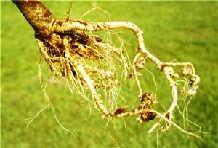 Most species of plant parasitic nematodes have a relatively simple life cycle consisting of the egg, four larval stages and the adult male and female.
Most species of plant parasitic nematodes have a relatively simple life cycle consisting of the egg, four larval stages and the adult male and female.- Development of the first stage larvae occurs within the egg where the first molt occurs. Second stage larvae hatch from eggs to find and infect plant roots or in some cases foliar tissues.
- Under suitable environmental conditions, the eggs hatch and new larvae emerge to complete the life cycle within 4 to 8 weeks depending on temperature.
- Nematode development is generally most rapid within an optimal soil temperature range of 70 to 80°F.
- Infected plants in patches in the field
- Formation of galls on host root system is the primary symptom
- Roots branch profusely starting from the gall tissue causing a ‘beard root’ symptom
- Infected roots become knobby and knotty
- In severely infected plants the root system is reduced and the rootlets are almost completely absent. The roots are seriously hampered in their function of uptake and transport of water and nutrients
- Plants wilt during the hot part of day, especially under dry conditions and are often stunted
- Nematode infection predisposes plants to fungal and bacterial root pathogens
- Primary: Egg masses in infected plant debris and soil or collateral and other hosts like Solonaceous, Malvaceous and Leguminaceous plants act as sources of inoculums.
- Secondary: Autonomous second stage juveniles that may also be water dispersed.
- Loamy light soils.
IPM for Papaya
To know the IPM practices for Papaya, click here.
Source: NIPHM and Directorate of Plant Protection, Quarantine & Storage
Last Modified : 2/13/2020
© C–DAC.All content appearing on the vikaspedia portal is through collaborative effort of vikaspedia and its partners.We encourage you to use and share the content in a respectful and fair manner. Please leave all source links intact and adhere to applicable copyright and intellectual property guidelines and laws.
RELATED ITEMS
Ber Insect and Mite Pests
This topic covers information about Ber Insect and...
Loquat Insect Pests
This topic provides information about Loquat Inse...
Guava: Insect and Pest Management
This topic covers the information related to Insec...
Custard Apple Insect management
This topic covers the information related to insec...
RELATED LANGUAGES
